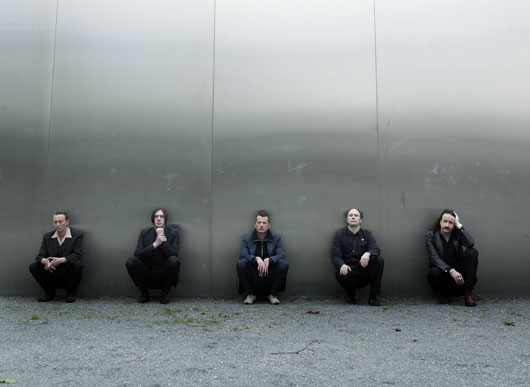Building an Iconic Sound: Einstürzende Neubauten
As the legend goes, in 1980, a West German punk named Blixa Bargeld set out […]

As the legend goes, in 1980, a West German punk named Blixa Bargeld set out to make an “ethnic” record. He wondered about his “authentic” background while listening to an Ethiopian folk record, and his attention turned to the debris that littered his own hometown’s streets. Along with the then-15-year-old Alexander Hacke, Bargeld’s group, Einstürzende Neubauten (German for “Collapsing New Buildings”), began crafting literal industrial music, with rhythms bashed out of scrap metal, pipes, power tools, shopping carts, and other West Berlin detritus. Thirty years later, the band is noisier than ever, having just released Strategies Against Architecture IV. Here, Hacke tells us more about the group’s DIY weapons of choice.
Unusual recording spots
One place we recorded was a motorway overpass, and there was a hollow air-conditioning shaft or a vent inside the [pillar]. There were some homeless people living there and a few clothes lying around… It had a very unique sound—you could stomp your feet and actually drum on the walls. There was great reverb… We also did some recordings in a water tower. It was a metal room in the shape of a ball. That was acoustically very interesting… your own voice was totally dry. If somebody was talking to you just a few feet away, you’d have a lot of echo and reverb that was completely dry, like you were in a completely dead room or a vacuum.
Contact microphones
So much of our work is researching materials and how to mic or pick up the sounds. With a contact mic, you can dive into the depth of these objects. It’s what you hear when you hold a resonating object to your ear; it’s a completely different way of recording than with a regular microphone. The contact mic really started our business.
Junk metal
We liked to do these nighttime excursions and look into building sites, and we were able to find wonderful objects. Air-conditioning parts were very useful as drums. The ribs on a shopping cart are like strings on a harp—you can play it if you pick it up properly with a contact mic. You can also put all of your shit in it for transportation!
“The Thirsty Animal”
The Thirsty Animal
What’s typical for Neubauten instruments is that they have far-reaching associations with their names. A lot of the times, the names of things don’t really describe what they are, but they are an image associated with a sound or the looks of them. For example, there was a brass instrument I used to play in the very early days, which was called the Thirsty Animal. It just had this very melancholic, wailing sound that we called “The Thirsty Animal.” It was just tubing that you find in any home-improvement shop. You could not only blow into it to make noise—you could also smoke with it.
Power Tools
We still use drills, mostly without the actual drill parts. We like the ones that go at different speeds, and it was the invention of the AccuDrill that was actually very helpful for our purposes. We’ve also been using power tools for installations, like attaching a wire to the rotating part of the power tool and then plucking or hitting other objects with that wire. It’s also an energetic thing; there is so much force and power in a little tool like that. It’s great to put these things to use just for the threat they bear. It’s like taming wildcats and snakes.
Tape loops
We would sometimes have tape running around the studio like, say, a 20-meter-long tape loop that was suspended all the way around the studio over microphones and cymbal stands. We would also experiment with cutting holes into tape, burning it, or piecing it together in weird ways. Not just quarter-inch but the multi-track, two-inch tape. We would cut the tapes and physically destroy them and see what we could come up with. Studio owners were not very happy with that.
“Haus der Lüge”
The Bass Spring
We still use it—it’s almost organically attached to Andrew [Chudy (a.k.a. N.U. Unruh)]. We use it as a bass drum. You can hit the actual spring, but you can also hit the frame and use the spring as a resonator. I think it came from an automotive shock absorber. There are different kinds of springs; some are meant to be squeezed and others are meant to be pulled. This one is meant to be pulled, like a counter-weight.
The Noodle
The Noodle is actually a noodle, like pasta. It’s called The Noodle because one version was like a drill but it is derived from an African instrument where you have a string held up by two rods and the rods are connected to a sort of drum, and you use the drum as a resonator. If you hit the two rods together, the pitch of the string would get lower. That was the inspiration for it—it was a cover version of this African instrument, except on a much larger scale.
Strategies Against Architecture IV is out now on Mute.
For more Building an Iconic Sound, jump to our features with Moby, Squarepusher, Geoff Barrow, and Mala.

